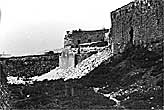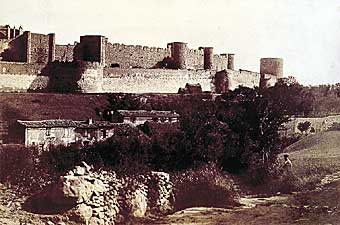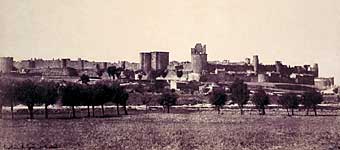 |
|
The north and north-east facade about 1850. Photograph by Léopold Verguet.
|
|
 |
|
Remains of the destroyed
Notre-Dame Tower.
Photograph by Léopold Verguet.
|
|
|
THE CITY BEFORE
THE RESTORATION
|
|
|
 |
The city seen from the south-east facade. Mission Héliographique
(heloigraphic department), Mestral and Le Gray, 1851. |
  n 1659, after the Treaty of the Pyrenees attached Roussillon to France,
The city lost its military and strategic role. The religious and civil
authorities were gradually transferred to the Lower Town (Ville Basse),
which was the new place of residence for the leading citizens and
middle classes. In 1804, Napoléon 1st removed the city from the list
of active fortified towns but kept the army there. Because of insufficient
means the army carried out minimal maintenance work on the fortifications.
Nonetheless, the ramparts were sold little by little and became open
air quarries for the Carcassonne contractors. As a result of the actions
of local intellectuals who were aware of this programmed destruction,
the old stronghold was reclassified in 1820 as a second category military
edifice. The Upper Town (Ville Haute), cloistered behind its now useless
fortifications, differed in every respect from the Saint-Louis
Bastide, which, with its drapery industry and trade,
was oriented to the future. The city seemed like a "backwater" whose
ruined walls gave free reign to romantic
visions: because of the dilapidated state of the fortifications,
the modest dwellings and poverty of the ordinary citizens the city
fitted the image of a poverty stricken, wretched world apart. The
majority of its citizens were cottage weavers. The modest working
class houses which were often dilapidated, occupied the lanes intra
muros and the lists
district. This population, affected by the crisis in the Carcassonne
textile industry, was in constant numerical and economic decline.
n 1659, after the Treaty of the Pyrenees attached Roussillon to France,
The city lost its military and strategic role. The religious and civil
authorities were gradually transferred to the Lower Town (Ville Basse),
which was the new place of residence for the leading citizens and
middle classes. In 1804, Napoléon 1st removed the city from the list
of active fortified towns but kept the army there. Because of insufficient
means the army carried out minimal maintenance work on the fortifications.
Nonetheless, the ramparts were sold little by little and became open
air quarries for the Carcassonne contractors. As a result of the actions
of local intellectuals who were aware of this programmed destruction,
the old stronghold was reclassified in 1820 as a second category military
edifice. The Upper Town (Ville Haute), cloistered behind its now useless
fortifications, differed in every respect from the Saint-Louis
Bastide, which, with its drapery industry and trade,
was oriented to the future. The city seemed like a "backwater" whose
ruined walls gave free reign to romantic
visions: because of the dilapidated state of the fortifications,
the modest dwellings and poverty of the ordinary citizens the city
fitted the image of a poverty stricken, wretched world apart. The
majority of its citizens were cottage weavers. The modest working
class houses which were often dilapidated, occupied the lanes intra
muros and the lists
district. This population, affected by the crisis in the Carcassonne
textile industry, was in constant numerical and economic decline. |
 |
| The city seen from the east facade. Mestral and Le Gray, 1851 |

|
|
 |
|


